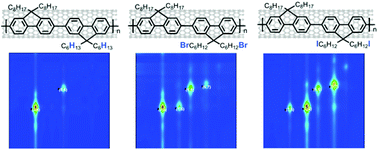Effect of side-chain halogenation on the interactions of conjugated polymers with SWNTs†
Abstract
Three fluorene-based π-conjugated copolymers, poly[(9,9′-dioctylfluorene)-alt-(9,9′-dihexylfluorene)] (PFO-FH), poly[(9,9′-dioctylfluorene)-alt-(9,9′-bis(6-bromohexylfluorene))] (PFO-FHBr), poly[(9,9′-dioctylfluorene)-alt-(9,9′-bis(6-iodohexylfluorene))] (PFO-FHI), which possess the same polymer backbones, were synthesized via Suzuki polycondensation. These three copolymers are practically identical in molecular structure and degree of polymerization. The only difference between them is the chain-end functionality of side-chains, which included hydrogen, bromine, and iodine, respectively. Each of these polymer structures was found to interact with the surface of single-walled carbon nanotubes (SWNTs), forming stable dispersions in organic solvents, such as THF. Using UV-Vis-NIR absorption, photoluminescence excitation (PLE) mapping, and Raman spectroscopy, it was found that the terminal atom of the polymer side-chains influenced the specific SWNT chiralities that were dispersed by the polymer.


 Please wait while we load your content...
Please wait while we load your content...